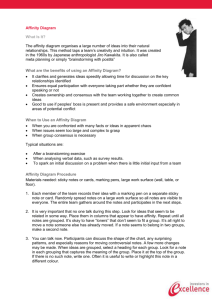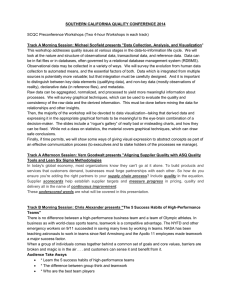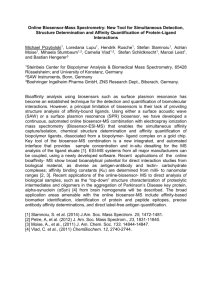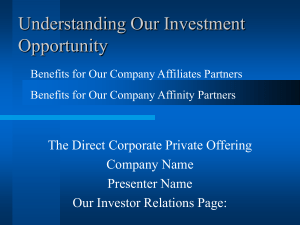chinger_MA_Premium
advertisement
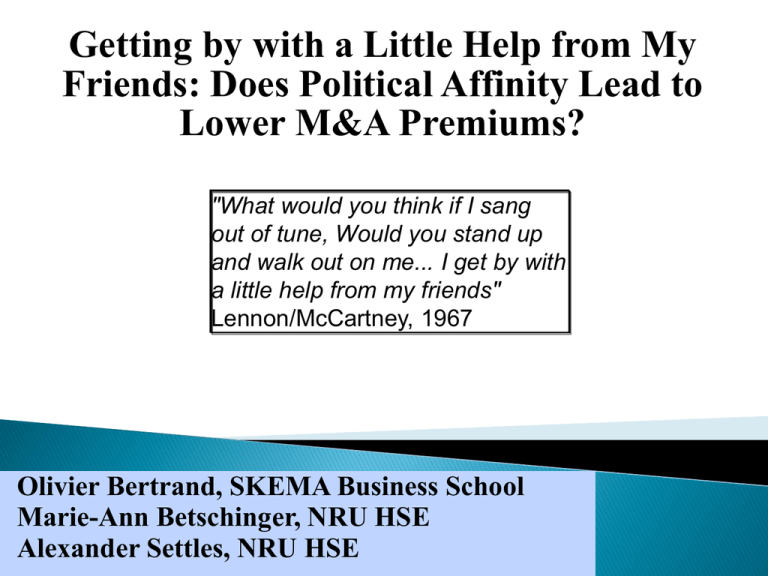
Getting by with a Little Help from My Friends: Does Political Affinity Lead to Lower M&A Premiums? "What would you think if I sang out of tune, Would you stand up and walk out on me... I get by with a little help from my friends" Lennon/McCartney, 1967 Olivier Bertrand, SKEMA Business School Marie-Ann Betschinger, NRU HSE Alexander Settles, NRU HSE Motivation Wikileak cables and the revelation of political intervention abroad (Lipton, Clark, and Lehren, 2011) Role of bilateral country relation and foreign policy for business deal making ◦ Investigation of the importance of political affinity (Gartzke, 1998) – an underlying driver of ‘special’ relationship between countries Focus on large cross-border acquisitions and decision-making during the M&A process ◦ Effect on the initial bid premium offered by acquirers Strategic parameter in deal-making (Eckbo, 2009) 2 Main Contribution Introducing international relations into M&A research ◦ Does the willingness of countries to pursue a cooperative or conflictual relationship with a partner country explain its actions in the business arena? ◦ Political affinity, defined as the similarity of national preferences in global affairs (Gartzke, 1998) Focus on the Acquisition process ◦ Still little on the acquisition process ◦ A few papers on the effect of host country environment on the level of bid premium (Rossi & Volpin, 2004; Bris & Cabolis, 2008) ◦ Governments as key stakeholder in M&A negotiations 3 Main Findings Based on a sample of 925 large cross-border deals Lower initial bid offer with a higher level of political affinity (as measured by UN voting patterns) Effect moderated by ◦ The size of acquirers and target firms ◦ The level of domestic political constraint faced by the host government 4 Why should it matter? (1) Bid premium and bargaining power 5 Bid premium ◦ Objective of the acquirer to pay as little as possible Initial bid premium as a direct function of the anticipated bargaining power of acquiring and target firms (Aktas, de Bodt, and Roll, 2010; Schwert, 2000) ◦ Target firm is advantaged due to information asymmetries ◦ But, acquirer heterogeneity in terms of Access to relevant information Ability to influence the decision made by the target firm Why should it matter? (2) Governments and M&A 6 Several facets of government involvement ◦ Regulator (Clougherty, 2005; Wan and Wong, 2009) ◦ Owner (Johnson and Mitton, 2003; Shleifer and Vishny, 1994) ◦ Customer/ supplier (Agrawal and Knoeber, 2001; Dinc, 2005). ◦ Government executives are usually part of vast networks that include political and business elites (Kadushin, 1995; Colignon and Usui, 2001) Government can also affect the negotiation outcome through: ◦ Information access (e.g., elite circles, investment bank links) ◦ Access to dependency relationships (e.g., regulation, major customer, public opinion) Why should it matter? (3) Cross-border M&A and political affinity In cross-border transactions: Larger influence of (no) help & two governments involved Political affinity ◦ Similarity of national preferences in global affairs In case of positive and high political affinity ‘global objectives coincide’(Gartzke, 1998) ◦ High political affinity provides a door for economic cooperation while disaffinity makes international deals more costly and difficult Hypothesis 1: The level of political affinity between acquirer and target countries is negatively related to the initial acquisition premium for cross-border M&As. Should it matter for all firms to the same degree? (1) Firm size and political affinity Firm size – proxy for resources (Moeller et al., 2004) ◦ More resources can be deployed to influence governments ◦ Higher ability to bear the fixed costs of establishing an infrastructure in the host market (Helpman, Melitz, and Yeaple, 2004; Salamon and Siegfried, 1977) More attention of government to bigger firms ◦ More visible and legitimate ◦ Larger popular support Should it matter for all firms to the same degree? (2) Firm size and political affinity Target firms Hypothesis 2: The relationship between the initial acquisition premium and political affinity is moderated positively by the size of the domestic target firm. Acquirer firms Hypothesis 3a(b): The relationship between the initial acquisition premium and political affinity is moderated positively (negatively) by the size of the foreign acquiring firm. Should it matter in all target countries to the same degree? Host government constraints and political affinity Trade-off between foreign policy and domestic interests (Putnam, 1988) Implementation of foreign policy objectives constrained by domestic political decision-making procedures (Besley and Case, 2003, Milner and Tingley, 2011) ◦ Formal approval ◦ Negative response from political partners or opponents Political accountability varies across political regimes Hypothesis 4: The relationship between the initial acquisition premium and political affinity is moderated positively by the level of domestic political constraints on the host government in the target country. Sample Final sample: 925 cross-border deals for the period 19902008 with an average four-week bid premium of 43% (source: Thomson ONE database) Model Pijt f Cijt , X ijt , Dijt , I j , Tt Political Affinity: Patterns of national interests revealed in United Nations (UN) voting behavior (see e.g., Gartzke, 1998). Spearman rank-order correlations of roll-call voting patterns in the UN General Assembly. Method ◦ Pooled least squares regressions – robust errors ◦ Fixed country/dyad effects in robustness check 0.15 Canada 1991 0.24 Canada 1994 0.77 Israel 1996 0.08 Canada 1995 0.72 Israel 2000 0.29 Canada 1996 0.72 Israel 2002 0.17 Canada 1997 0.68 Israel 2003 0.13 Canada 1998 0.79 Israel 2004 0.16 Canada 1999 0.65 Israel 2005 0.15 Canada 2000 0.56 Israel 2008 0.07 Canada 2001 -0.01 Canada 2002 -0.39 S. Africa 2001 0.03 Canada 2003 -0.69 S. Africa 2008 0.03 Canada 2004 -0.03 Canada 2005 -0.37 Mexico 1999 -0.03 Canada 2006 -0.36 Mexico 2000 0.09 Canada 2007 -0.52 Mexico 2002 0.12 Canada 2008 VARIABLES Model 1 Model 2 Political Affinity -10.02*** (3.509) -21.05*** (7.708) Political Affinity (Lagged one year) Difference in Political Systems between Countries Cultural Distance Difference in Shareholder Protection between Countries Difference in GDP per Capita between Countries Difference in Size between Acquiror and Target Acquiror ROA Target ROA Acquiror Debt Ratio Target Debt Ratio Acquisition Experience State-Owned Acquiror Stake Sought Completed Deal Multiple Bidders Tender Offer Cash Payment Financial Acquiror Hostile Acquisition Horizontal Acquisition 0.560 (0.714) 0.0381 (1.094) -0.0929 (1.291) 3.090* (1.691) 2.164** (0.887) -0.876 (15.83) 21.16 (26.83) -16.60** (7.600) 1.718 (5.620) -0.403* (0.228) 1.153 (14.79) 0.399*** (0.0849) 10.55** (4.552) 15.70*** (4.161) 7.093*** (2.672) 1.620 (2.720) 1.213 (6.700) 0.00406 (4.420) 1.137 (2.630) 0.166 (1.150) 0.644 (1.761) -1.721 (1.838) 1.050 (7.229) 4.884*** (1.724) 7.748 (22.62) 23.52 (31.03) -43.81** (18.87) 40.43* (23.25) -0.655* (0.336) -2.680 (21.04) 0.318 (0.245) 13.14** (6.057) 25.53*** (6.110) 9.936** (4.406) 2.829 (4.326) Model 3 Model 4 Model 5 Model 6 -9.156** (3.697) -6.902*** (2.187) -7.567** (3.657) -9.093** (3.533) 0.639 (0.719) -0.124 (1.104) -0.0447 (1.282) 2.921* (1.688) 2.093** (0.878) -0.0779 (15.80) 20.83 (26.90) -15.83** (7.670) 1.618 (5.619) -0.387* (0.229) -1.500 (16.81) 0.403*** (0.0858) 10.57** (4.260) 15.77*** (4.162) 6.875*** (2.628) 1.729 (2.699) 0.611 (0.728) 0.243 (1.257) 0.185 (1.372) 2.963* (1.720) 2.208** (0.895) 0.174 (16.02) 23.77 (27.34) -16.62** (7.699) 1.463 (5.732) -0.479** (0.232) -1.200 (16.79) 0.404*** (0.0864) 10.11** (4.326) 14.88*** (4.223) 7.017*** (2.710) 1.787 (2.772) 1.004 (0.669) 0.0698 (0.787) -0.193 (1.205) 3.299** (1.602) 2.525*** (0.370) -0.398 (5.657) -2.814 (6.553) -4.678 (2.973) -2.814 (2.415) -0.244*** (0.0933) -13.89** (6.566) 0.512*** (0.0412) 4.429** (1.941) 10.70*** (2.053) 3.850*** (1.168) 4.102*** (1.175) 0.903 (0.758) 0.175 (1.270) -3.002** (1.333) 2.401 (1.904) -1.315* (0.716) -23.02* (12.81) -0.104 (0.306) 16.90* (10.20) 0.385*** (0.104) 10.41** (5.096) 14.33*** (4.767) 6.214** (2.834) 4.521 (2.800) 3.050 (10.30) -31.98** (15.37) 5592 0.108 930 0.069 Acquisition Prediction Constant Observations R-squared 3.060 (20.45) 6.452 (28.04) 1.022 (20.57) 0.109 (0.191) -15.22 (18.58) 925 0.121 941 0.119 915 0.116 895 0.117 0.794 (6.257) Political affinity matters! Moderating Effect: Firm Size Moderating Effect: Host government To summarize: Main findings Our hypotheses are supported ◦ Hypothesis 1 Political Affinity is negative (p<0.01) ◦ Hypothesis 2 Interaction affinity and target size is positive (p< 0.01) ◦ Hypothesis 3 (b) Interaction affinity and acquirer size is positive (p<0.1) ◦ Hypothesis 4 Interaction affinity and domestic political constraint is negative (p<0.05) 16 Robustness checks Additional control variables (financial acquirer, hostile acquisition, horizontal acquisition) Different dependent variables ◦ Log-transformed value of initial bid premium ◦ Final bid premium Reverse Causality ◦ Lagged value of political affinity measure Selection: ◦ Predicted number of deals between country dyads as a regressor ◦ Inclusion of domestic deals in the sample ◦ Matching with domestic deals Fixed effects – target country, acquirer country, dyad US dummy – does not change the results Conclusion Contribution to the literature: ◦ Linking international relations and finance & strategy ◦ M&A process “Practical” Takeaways ◦ Close examination of bilateral country relationship during the due diligence process ◦ Value of political connections at home when going abroad Limitations to the paper ◦ “Large firm” bias ◦ Almost no state-owned firms and privatization cases ◦ Firm size as a proxy of (political) resources Thank you for you attention! Back-up Why should it matter? Examples of Politicians-Business Networking Shortly after his election, French President François Hollande met German topexecutives to discuss economic issues during a dinner in Paris (Gallois and Lemaître, 2012) As an example of economic-political network, Alexander Dibelius, a top-banker in particular on M&A issues at Goldman Sachs Germany, had contacts with Angela Merkel long before she was nominated as a chancellor for Germany. For instance, Dibelius organized dinner meetings for Merkel with businessmen (Reischauer and Zdral, 2006). For instance, the former head of Morgan Stanley Germany, Dirk Notheis, was a member of the Christian Democratic Union – the party of the current German chancellor Angela Merkel. Recently revealed e-mails point at his active use of party connections for business dealmaking (WirtschaftsWoche, 2012) In a French newspaper a French entrepreneur describes his participation in a government led business delegation and explains how the French government has introduced him to top businesses in India (Flamand, 2010) Why should it matter? Examples of Goverment Interference in Deals in the acquisition battle over Aventis in 2004, the Swiss firm Novartis lost out against the French firm Sanofi-Synthelabo despite a higher offer price; the French government put pressure on the target management to accept the deal (Gelman, 2007). When Novartis started bidding for Aventis the French Prime Minister Jean-Pierre Raffarin publically announced that the target products were essential for the defense of the country against bio-terrorism, increasing public hostility towards the Swiss offer (Gelman, 2007) the Spanish government enacted new rules and imposed more restrictions in the electricity and gas market to stop the German firm E.On to acquire the Spanish firm Endesa (Clifton and Diaz-Fuentes, 2011 After the end of the Cold War the US Department of Defense encouraged consolidation of the defense industry as the procurement of new weapons systems seemed ready to decline (Hensel, 2010) When Zhejiang Geely Holding Group of China took over Sweden’s Volvo the government played an important role in placating union concerns regarding a Chinese owner (Leung, 2010) Why should it matter? Host-home Government Interference in Business Baron (1995) depicts the U.S. government involvement in the entry of Toys ‘R’ Us in Japan, while Frynas, Mellahi and Pigman (2006) explain the role of GermanChinese interstate relations when Volkswagen came to China Henisz and Zelner (2005) exemplify that the intervention may be as simple as a phone call such as a phone call that a former regulatory official in Argentina received from George W. Bush (the son of then President-elect George H.W. Bush) about investments of Enron. Acquisition by UK’s Cable and Wireless (C&W) of Japan’s International Digital Communications corporation. According to Saner et al. (2000: 82), the deal succeeded due to the firm ‘coordinating its moves with the UK government, the U.K. Embassy in Japan and other equally supportive foreign country governments [...].’ Examining the entry of Lockheed Martin into Russia in 1993, Frynas et al. (2006) highlight the importance of the good relationship between the Clinton and Yeltsin governments and how this entailed, for instance, the signature of a bilateral treaty removing technology transfer barriers. ‘All of this was made possible by a favorable political business environment. U.S.-Russian public cooperation in the space sector gave a privileged position to U.S. companies in Russia’s economy’ (Frynas et al., 2006: 335). Why should it matter? (3) Governments and cross-border deals International transactions are even more challenging ◦ Higher information asymmetry ◦ Lower embeddedness in the host market Role of host but also home government during the M&A process ◦ Political intervention abroad (e.g., Toys’R’s Us in Japan, Baron (1995); Volkswagen in China, Frynas, Mellahi and Pigman, (2006)) ◦ Simple or more complex form of intervention Independent variables ◦ Political affinity UN voting patterns (see e.g., Gartzke, 1998, 2000). ◦ Size of the firm Log (total assets) ◦ Domestic political constraints Executive constraints Government fractionalization Polity score Control variables ◦ Country-level variable Difference in political system between countries Cultural distance Difference in shareholder protection between countries Difference in GDP per capita between countries Control variables ◦ Firm-level variables Difference in size between target and acquirer Acquirer ROA Target ROA Acquirer debt ratio Target debt ratio Acquisition experience State-owned acquirer Control variables ◦ Deal-level variables Stake sought Completed deal Multiple bidders Tender offer Cash payment ◦ Year and industries dummies Descriptive Statistics 1 2 3 4 5 6 7 8 9 10 11 12 13 14 15 16 17 VARIABLES Political Affinity Difference in Political Systems between Countries Cultural Distance Difference in Shareholder Protection between Countries Difference in GDP per Capita between Countries Difference in Size between Acquiror and Target Acquiror ROA Target ROA Acquiror Debt Ratio Target Debt Ratio Acquisition Experience State-Owned Acquiror Cash Payment Multiple Bidders Tender Offer Stake Sought Completed Deal Mean 0.332 0.497 1.741 -0.108 -0.106 2.431 0.113 0.024 0.55 0.513 3.091 0.008 0.583 0.111 0.59 94.197 0.923 S.D. 0.378 1.758 1.158 1 0.725 1.884 0.109 0.075 0.217 0.277 5.196 0.087 0.493 0.315 0.492 13.106 0.266 1 1 -0.0401 0.0987 -0.0707 0.1285 -0.0808 -0.0725 0.043 0.1021 0.116 -0.0625 0.0834 -0.1312 0.0406 0.2099 -0.186 -0.0858 2 3 4 5 6 7 8 9 10 11 12 1 0.373 0.0443 0.0578 0.0138 0.0095 -0.035 -0.0477 0.0248 -0.0014 0.0037 -0.03 -0.018 -0.0307 -0.2357 0.0007 1 -0.0333 -0.1012 -0.0315 0.0021 0.0065 0.0593 0.0206 -0.0084 0.02 0.0407 -0.0728 0.0804 -0.1961 0.0171 1 0.1291 -0.0482 -0.0093 0.0467 0.0244 0.0135 -0.0188 0.0366 0.0148 -0.1425 -0.1373 -0.0837 0.0649 1 0.0856 -0.044 0.0012 0.0527 0.0213 0.0827 0.0034 -0.1364 0.0064 0.0416 -0.1707 -0.0365 1 0.0878 -0.3465 0.1441 -0.0543 0.3869 -0.0072 0.2022 -0.019 0.0462 -0.0914 0.053 1 0.231 -0.0727 -0.0428 0.0253 -0.008 0.1541 0.0626 0.0888 0.0054 -0.0189 1 0.014 0.0375 -0.0758 -0.0128 -0.0108 0.0924 -0.0148 0.049 -0.0513 1 0.4032 0.1569 0.0487 0.0633 -0.0076 0.0645 -0.0734 0.0216 1 0.0034 0.057 -0.0161 0.0036 0.042 -0.0848 0.0039 1 0.0033 0.0722 0.0243 -0.0439 -0.0698 -0.0474 1 -0.0526 0.0881 -0.0033 -0.0756 -0.0685 13 14 15 16 17 1 0.0138 1 0.2222 0.0503 1 -0.0351 0.0502 0.0053 1 0.0278 -0.4014 0.0488 -0.0196 1

